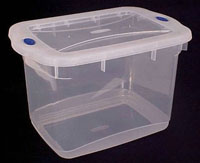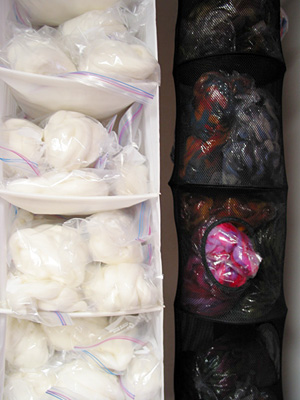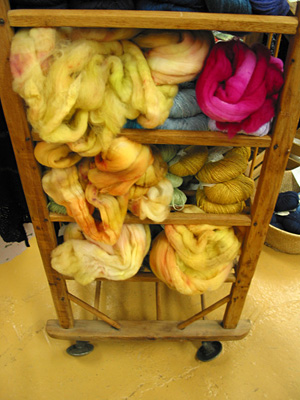Stash Storage
Fall heralds the peak and subsequent
end of fiber fest and agricultural fair season,
better known as Stash Acquisition Time. Gather
ye fleeces while ye may -- the kids can store
their clothes in the bathroom or the garage,
right?
But wait -- no need to panic. There are some
great, and great-looking options for storing
your spinning fiber no matter what your living
situation. (While I'm referring to fiber here,
most options will also apply to yarn, too). Your
storage space may be limited to undesirable areas
of your house or apartment, but that doesn't
mean your fiber has to suffer. Remember these
three things: fiber needs to be stored dry, protected
against moths and other insects, and easily accessible.
Everything else is a matter of personal taste
and floorspace.
BASEMENT/GARAGE
  If
you've only got space in the basement or a damp
garage, plastic tubs are your friend. Readily
available at discount stores, choose clear plastic
whenever possible unless your space is lit with
direct sunlight, which may affect unstable dye
colors. Clear plastic makes it easier to hunt
down a certain color or fiber type; alternately,
label the bins with tape. "2007 Rhinebeck
fleeces" or "Dyed Corriedale top, various
colors," etc. Apartment building storage
lockers tend to be damp and small (not to mention
flooded when you least expect it, according to
anecdotal evidence from many renting friends)
-- sealed plastic tubs will help keep your fiber
safe no matter what happens. Mice and other apartment-building
fauna love to nest in fiber, so the more solid
the seal on your tubs, the better. [Tub
at left by Rubbermaid] If
you've only got space in the basement or a damp
garage, plastic tubs are your friend. Readily
available at discount stores, choose clear plastic
whenever possible unless your space is lit with
direct sunlight, which may affect unstable dye
colors. Clear plastic makes it easier to hunt
down a certain color or fiber type; alternately,
label the bins with tape. "2007 Rhinebeck
fleeces" or "Dyed Corriedale top, various
colors," etc. Apartment building storage
lockers tend to be damp and small (not to mention
flooded when you least expect it, according to
anecdotal evidence from many renting friends)
-- sealed plastic tubs will help keep your fiber
safe no matter what happens. Mice and other apartment-building
fauna love to nest in fiber, so the more solid
the seal on your tubs, the better. [Tub
at left by Rubbermaid]
ATTIC/BARN/HIGH-CEILINGED GARAGE
If you're lucky enough
to have an attic, barn or high-ceilinged garage,
you can store fiber the way the pros do...
and by "pros," I
mean sheep farmers. Gather up all your old pillowcases
-- garage sales are a great place to stock up
on these. Using a sturdy piece of yarn or twine
(hemp works well) and a large needle, thread
a long piece of yarn through the channel at the
open end of the pillowcase, fill it full of fiber,
and hang it from the ceiling beams with an s-hook
or similar piece of hardware. At the sheep farm
where I bought my first fleece, they used sheets,
one per fleece, and hung them from part of the
barn ceiling. The fabric allows air circulation
but keeps it off the floor and away from mice
or other pests. Put in a sachet of anti-moth
herbs in each bundle and you'll not only scare
insects away, but make the room smell nice, too.
  A variant of this option, for those of you who
have sturdy drop ceilings and no pest problem:
store lightweight bags of fleece overhead between
the drop ceiling and the actual one. Don't forget
they're there -- and periodically check to make
sure nothing's gotten into the bags. This option
is not recommended for stinky raw fleeces, unless
you have really bad houseguests and want to send
them home. A variant of this option, for those of you who
have sturdy drop ceilings and no pest problem:
store lightweight bags of fleece overhead between
the drop ceiling and the actual one. Don't forget
they're there -- and periodically check to make
sure nothing's gotten into the bags. This option
is not recommended for stinky raw fleeces, unless
you have really bad houseguests and want to send
them home.
CLOSET
Closets are an obvious choice
if you're trying to keep the fiber away from
curious kids or pets (or hiding your latest acquisition
from your significant other...not that you'd
do that, right? *cough, cough*). If you've got
just a little bit of space, get shoe
or sweater organizers from IKEA -->
They hang directly from the closet
rod and will fit quite a bit of fiber in each
cubbyhole. An entire closet? Build shelves across
the back or hang fiber from the wall and closet
rod in bags with s-hooks.
OUT IN THE OPEN
Lucky spinner! You've
got yourself a studio space or an exceptionally
understanding significant other. Here's where
the storage and display gets fun. All photos
were taken at River Colors Studio in Lakewood,
Ohio, with the exception of the IKEA hanging
shoe rack and mesh "tunnel," from
my shop Stitch
Cleveland
  <--Lantern
Moon seagrass towers, shown at left.
Available, along with many other beautiful and
practical display options, at lanternmoon.com (look
under "accessories.") <--Lantern
Moon seagrass towers, shown at left.
Available, along with many other beautiful and
practical display options, at lanternmoon.com (look
under "accessories.")
Advantages: sturdy, purpose-built, attractive.
Disadvantages: cost, not for homes with toddlers
or naughty pets.
Wire racks. Can be wall-mounted, mounted inside
wall depressions (many older houses have spaces
that formerly housed built-in shelving or cabinetry)
or placed on an attic or basement wall.
Advantages:
great air circulation, cost-effective, widely
available.
Disadvantages: no appropriate walls
for placement or can't install in rental apartment,
fiber can slip off the sides easily if not
blocked with something.
Bookshelves. Depending on
the size of your stash, you might even be able
to fill in the space above existing books (don't
try this with greasy straight-off-the-sheep fleeces,
though). Advantages: reasonably priced, available
at home improvement and discount stores, easy
to put together, effective use of floorspace.
Disadvantages: takes up lots of wall space, lower
shelves accessible to toddlers and pets.
  Antique
shoe racks --> Antique
shoe racks -->
Advantage:
great air circulation, on rollers, fits in a
mudroom or back of a closet. Disadvantage: Hard
to find, keep an eye on garage sales and auctions.
A special note for raw, as-yet-uncleaned
fleeces: their sticky- and often stinkiness can
preclude storing them in the open. Either wash
them first, or seal in plastic bags before putting
into containers full of other fiber (if you don't
have enough space to separate them from the flock).
Air them out at least every few months, and don't
store them in extreme temperatures, as the various
sheepy fluids can coagulate nastily -- or at
the very least, make them more difficult to wash
later.
No matter how you choose to store your fiber,
keep it dry, away from pests and as easily accessible
as you can given your own living situation, and
you'll be much more likely to use it throughout
the year! |

